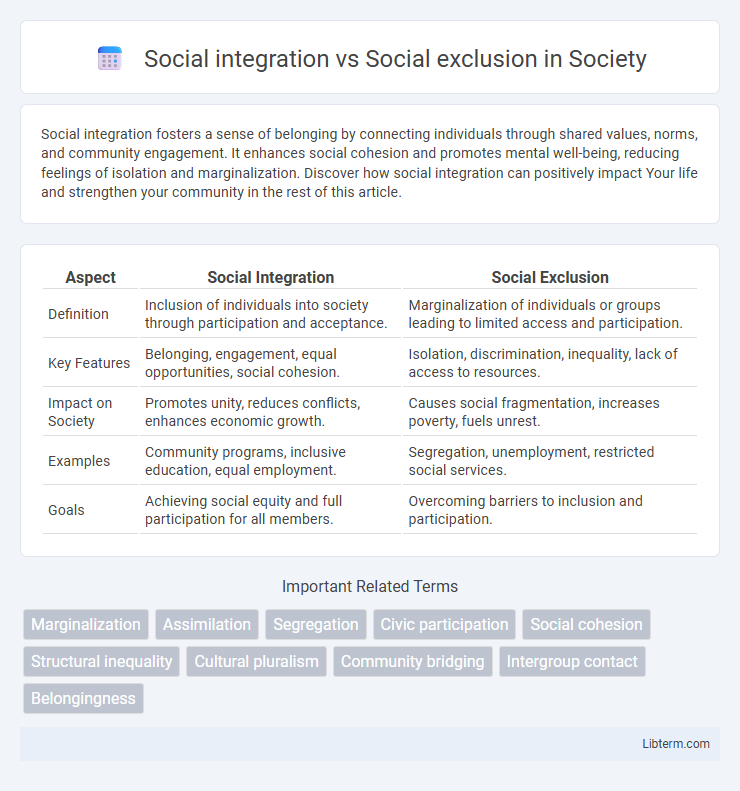Social integration fosters a sense of belonging by connecting individuals through shared values, norms, and community engagement. It enhances social cohesion and promotes mental well-being, reducing feelings of isolation and marginalization. Discover how social integration can positively impact Your life and strengthen your community in the rest of this article.
Table of Comparison
| Aspect | Social Integration | Social Exclusion |
|---|---|---|
| Definition | Inclusion of individuals into society through participation and acceptance. | Marginalization of individuals or groups leading to limited access and participation. |
| Key Features | Belonging, engagement, equal opportunities, social cohesion. | Isolation, discrimination, inequality, lack of access to resources. |
| Impact on Society | Promotes unity, reduces conflicts, enhances economic growth. | Causes social fragmentation, increases poverty, fuels unrest. |
| Examples | Community programs, inclusive education, equal employment. | Segregation, unemployment, restricted social services. |
| Goals | Achieving social equity and full participation for all members. | Overcoming barriers to inclusion and participation. |
Understanding Social Integration
Social integration refers to the process by which individuals or groups are incorporated into the social structure of a community through participation, acceptance, and equal access to resources and opportunities. Understanding social integration involves examining factors like social networks, cultural norms, economic inclusion, and institutional support that promote cohesion and reduce barriers for marginalized populations. Effective social integration fosters a sense of belonging, social stability, and mutual respect, which contrasts with social exclusion characterized by discrimination, segregation, and unequal access to essential services.
Defining Social Exclusion
Social exclusion refers to the systematic marginalization of individuals or groups from essential social, economic, and political resources, resulting in limited access to education, employment, healthcare, and community participation. This phenomenon contributes to persistent inequalities by isolating affected populations from the benefits of social integration and full societal engagement. Addressing social exclusion requires targeted policies that promote inclusion, equal opportunity, and the reduction of structural barriers.
Key Differences: Social Integration vs Social Exclusion
Social integration involves the active inclusion of individuals into societal systems through equal access to resources, opportunities, and rights, fostering social cohesion and participation. Social exclusion, conversely, denotes the systematic marginalization and deprivation from social, economic, and political spheres, resulting in inequality and limited social mobility. The key difference lies in social integration promoting unity and empowerment while social exclusion leads to isolation and disadvantage.
Causes of Social Exclusion
Social exclusion stems from factors such as poverty, discrimination, lack of education, and limited access to healthcare, which marginalize individuals or groups from mainstream society. Ethnic, racial, and gender inequalities often exacerbate exclusion by restricting social, economic, and political opportunities. Structural issues like unemployment, inadequate housing, and social stigma further deepen the divide between integrated communities and excluded populations.
Benefits of Social Integration
Social integration enhances community cohesion by fostering a sense of belonging and mutual support, which improves mental health and reduces stress levels among individuals. It promotes equal access to resources like education, employment, and healthcare, leading to economic stability and reduced poverty rates. Increased social integration also encourages cultural exchange and diversity appreciation, boosting innovation and social resilience in dynamic societies.
Impact of Social Exclusion on Individuals
Social exclusion severely impacts individuals by limiting access to essential resources such as education, employment, and healthcare, leading to increased poverty and social isolation. This marginalization often results in psychological distress, including depression and low self-esteem, which hinders personal development and community participation. Studies show that long-term social exclusion exacerbates inequality, reducing overall societal cohesion and economic productivity.
Community Strategies for Social Integration
Community strategies for social integration emphasize inclusive programs that promote equal access to education, employment, and healthcare to reduce social exclusion. Initiatives such as community centers, cultural exchange events, and participatory decision-making foster trust and belonging among diverse groups. Effective social integration enhances social cohesion, mitigating risks associated with social exclusion like poverty, discrimination, and marginalization.
Barriers to Achieving Social Inclusion
Barriers to achieving social inclusion include systemic discrimination, economic inequality, and limited access to education and healthcare services. Social exclusion often stems from stigmatization based on race, gender, disability, or socioeconomic status, creating significant obstacles to participation in community and employment opportunities. Overcoming these barriers requires comprehensive policy reforms and targeted programs that promote equal opportunities and foster inclusive environments.
Role of Policy in Bridging Social Gaps
Effective social policies play a critical role in bridging social gaps by promoting inclusion through targeted welfare programs, education access, and anti-discrimination laws. Policies that facilitate equitable resource distribution and community engagement foster social integration, reducing marginalization and exclusion of vulnerable groups. Strategic government interventions in housing, employment, healthcare, and social services are essential to create inclusive societies and diminish social disparities.
Future Perspectives on Inclusive Societies
Future perspectives on inclusive societies emphasize leveraging technology and policy reforms to reduce social exclusion and foster social integration. Innovations in digital platforms can enhance access to education, employment, and community participation for marginalized groups, promoting equity and cohesion. Sustainable social inclusion requires collaborative efforts between governments, organizations, and communities to dismantle systemic barriers and create environments where diversity is valued and supported.
Social integration Infographic

 libterm.com
libterm.com